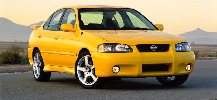![]()
|
Sentra
SE-R History

For the 1991 model year, Nissan debuted the third generation of its entry-level model, the Sentra. The clean lines of the new Sentra made a clean break between it and the previous generation, and so did a new model designation – SE-R.
From initial appearances, the Sentra SE-R looked to be a two-door Sentra sedan with alloy wheels, front and rear spoilers and fog lamps. It also had grippy, well-bolstered seats. But it was mechanically where the SE-R distinguished itself from lesser Sentras. A 140-horsepower SR20DE 2.0-liter DOHC 4-cylinder engine was installed in the engine bay. Backing this potent engine was a close-ratio 5-speed manual transmission and a viscous limited-slip differential. A sport-tuned suspension with front and rear anti-roll bars and 4-wheel disc brakes with optional ABS gave the SE-R handling and braking to match its powerplant.
The SE-R was immediately subject to critical and enthusiast acclaim and voted by Car and Driver magazine to its 1991 "10 Best" list. The SE-R was compared to the BMW 2002 and Datsun 510, legendary sports sedans from the late 1960s and early 1970s.
Over the four model-year run of the Sentra SE-R (1991-1994), changes were relatively minor – cruise control became available in 1992, a different front spoiler and interior revisions in 1993. The media, however, still honored the SE-R with awards – it was one of Car and Driver’s "10 Best" in 1992, 1993 and 1994 as well as one of their "10 Best Unheralded Performance Cars" (1993), Automobile’s "All-Stars" in 1993 and 1994 and one of their "Screaming Deals" (1993).
Sentra SE-R also became a favorite in grassroots motorsports events, racking up many victories in numerous autocrosses and track events, as well as off-road rallying.
The SE-R was taken out of the Sentra lineup with arrival of the fourth generation 1995 model, although many SE-R clubs and events, motorsports competition and magazine project vehicles kept the SE-R legend alive. When the fifth generation 2000 Sentra sedan was introduced last year in GXE and SE models with enhanced style and performance, a logical platform was provided for the return of the SE-R.
For the 2002 model year, there will be two Sentra SE-Rs – a 170-horsepower SE-R and the advanced-design 180-horsepower SE-R Spec V. The new SE-R features an all-new 2.5-liter DOHC 4-cylinder, named QR25. This engine allows SE-R to launch off the line with the authority of vehicles having twice the engine size.
Backing this new engine is a 6-speed manual transmission (SE-R Spec V) or a 5-speed manual or 4-speed automatic transmission (SE-R). The SE-R Spec V features 17-inch wheels and tires (16-inch on SE-R), as is a helical limited-slip differential (not available on SE-R). Sport suspension and large 4-wheel disc brakes with available ABS give braking and handling performance on par with the QR25’s output.
While the original SE-R was a fairly basic 2-door, there has been a large effort to make the new 4-door SE-R look different from a Sentra GXE. An aggressive front fascia, similar to the Japanese-market Skyline GT-R, along with side-sill extensions, a rear spoiler and large alloy wheels, announce SE-R’s intentions as a serious sporting machine.
"This new SE-R will continue the original’s legacy as the ultimate value-driven sports sedan," said Bill Kirrane, vice president and general manager, Nissan division. "This one is fun!"